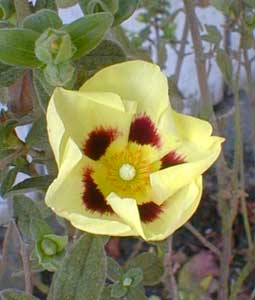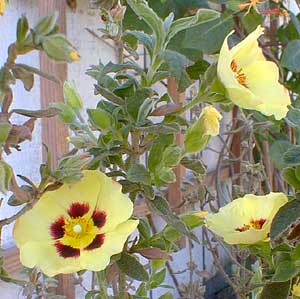
'Merrist Wood Cream'
Shrubby Rockrose
"My life is like the summer rose
That opens to the morning sky,
But ere the shades of evening close
Is scattered on the groundăto die."
-Richard Henry Wilde
(1789-1847)
The pubescent grey-green little evergreen leaves & rather upright habit make this Shrubby Rockrose H. wintonensis 'Merrist Wood Cream' the twin of H. wintonensis (Hillier) from which it originated as a color variant.
They are twins only when not in flower, as each has distinct blossoms. 'Merrist Wood Cream' has flat, round creamy or primrose-yellow flowers with dark yellow anthers, separated by a zone of chocolately marroon-red. The original "Hillier's" shrubby rockrose is pearly white where "Merrist" has the creamy yellow.
The regular "Hillier" originated as a self-seeded cross of Cistus salviifolius with Halimium ocymoides, though some sources say it crossed with H. lasianthum 'Formosum.' The yellow variant was discovered as a random sport on a shrub at Merrist Wood Agricultural College in Surrey, England.
The sport was preserved & developed at their horiticultural station & released to the gardening world in 1970.
 Merris Wood College was founded in 1945, originally called the Surrey Farm Institute. The college nursery produces many container-grown shrubs wholesaled to nurseries.
Merris Wood College was founded in 1945, originally called the Surrey Farm Institute. The college nursery produces many container-grown shrubs wholesaled to nurseries.'Merrist Wood Cream,' a recipient of the Award of Garden Merit, & is a great water-conserving plant. It needs almost no attention to flower gorgeously. It will remain healthy & vibrant year-round, just so long as it is never too wet. The height of its flowering is in June, but it begins in May (with some random early blooms at mid-April) & will rebloom throughout summer.
Ours grows along with a regular "Hillier" shrubby rockrose down an alley where it's difficult to water regularly, & these rockroses welcome just such dryness.
When sun strikes it from only one side during the day, it will tend to gain more of a lean. With fully encompassing sunlight morning & afternoon, it grows upright to two or three feet.
It can spread wider than tall, but should be sheered to remain narrower. Pruning it every spring will keep it compact, as otherwise it will get leggy & unappealing. Unlike most rockroses, neither the original "Hillier" nor its offspring 'Merrist' are densely enough leafed to serve as weed-suppressing groundcovers, as they've an airier tendency keeping their branches visible.